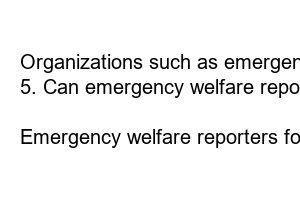긴급복지 신고의무자 교육
Title: Emergency Welfare Reporter Training: Empowering Communities During Crisis
Introduction:
In times of crisis, the role of emergency welfare reporters becomes pivotal in providing crucial information and support to affected communities. With their specialized training and expertise, these reporters play a vital role in ensuring timely assistance, coordinating relief efforts, and disseminating accurate information. This blog post highlights the significance of emergency welfare reporter training and the impact it has on communities during unforeseen emergencies.
1. The Need for Emergency Welfare Reporter Training:
Engaging and harnessing the power of local reporters in emergency situations significantly enhances response efforts and facilitates a better understanding of community needs. Emergency welfare reporter training equips individuals with essential skills such as crisis communication, information management, and community engagement, enabling them to effectively support affected communities.
2. Essential Skills and Tools:
During the training, participants learn to master critical skills like conducting effective interviews, writing informative news articles, and utilizing various digital platforms for information dissemination. With access to essential tools such as smartphone apps and communication software, reporters can efficiently gather and relay vital information in real-time.
3. Building Trust and Collaboration:
Successful emergency response relies on trust and collaboration between welfare reporters and the community. Training emphasizes building relationships, enhancing cultural sensitivity, and understanding the unique challenges faced by affected populations. By fostering trust and collaboration, reporters become better equipped to advocate for the needs of the community, allowing for more informed decision-making during emergencies.
4. Crisis Response Planning:
Emergency welfare reporter training also includes crisis response planning, imparting knowledge on incident command systems, emergency protocols, and effective team coordination. Armed with this expertise, reporters can work alongside emergency officials, NGOs, and other stakeholders, ensuring a cohesive and organized response during times of crisis.
5. Harnessing Digital Media:
In today’s digital age, effective utilization of digital media channels is essential in disseminating timely information to a wide audience. Training equips reporters with the skills to harness the power of social media, websites, and online platforms to relay critical updates and emergency advisories, ultimately improving community preparedness and response.
6. Community-Based Disaster Management:
A key aspect of emergency welfare reporter training is educating participants on community-based disaster management. By actively involving community members in emergency planning, response, and recovery efforts, reporters empower and strengthen local capabilities, fostering resilience and self-sufficiency.
Summary:
Emergency welfare reporter training plays a vital role in preparing individuals to provide critical support and information during emergencies. The training equips reporters with essential skills, tools, and crisis response planning knowledge. By building trust and collaboration with affected communities, harnessing digital media, and promoting community-based disaster management, welfare reporters become an indispensable asset, enhancing emergency response efforts and aiding in community recovery.
FAQs:
1. Can anyone become an emergency welfare reporter?
Yes, anyone with a passion for helping others and the willingness to undergo the necessary training can become an emergency welfare reporter.
2. How long does the training typically last?
The duration of the training can vary, but it often ranges from a few days to several weeks, depending on the depth and scope of the course.
3. Are there any prerequisites for enrolling in emergency welfare reporter training?
While there are no specific prerequisites, individuals with a background in journalism, communications, or community service may find the training particularly beneficial.
4. Where can one find emergency welfare reporter training programs?
Organizations such as emergency management agencies, NGOs, and journalism institutes often offer training programs for aspiring emergency welfare reporters.
5. Can emergency welfare reporters work in any type of emergency situation?
Yes, emergency welfare reporters are trained to respond to various emergency situations, including natural disasters, public health crises, and humanitarian emergencies.
6. How does the role of an emergency welfare reporter differ from that of mainstream journalists?
Emergency welfare reporters focus specifically on providing information, resources, and support to affected communities during times of crisis. Their role is more community-oriented and complements the work of mainstream journalists who report on broader aspects of the emergency.

